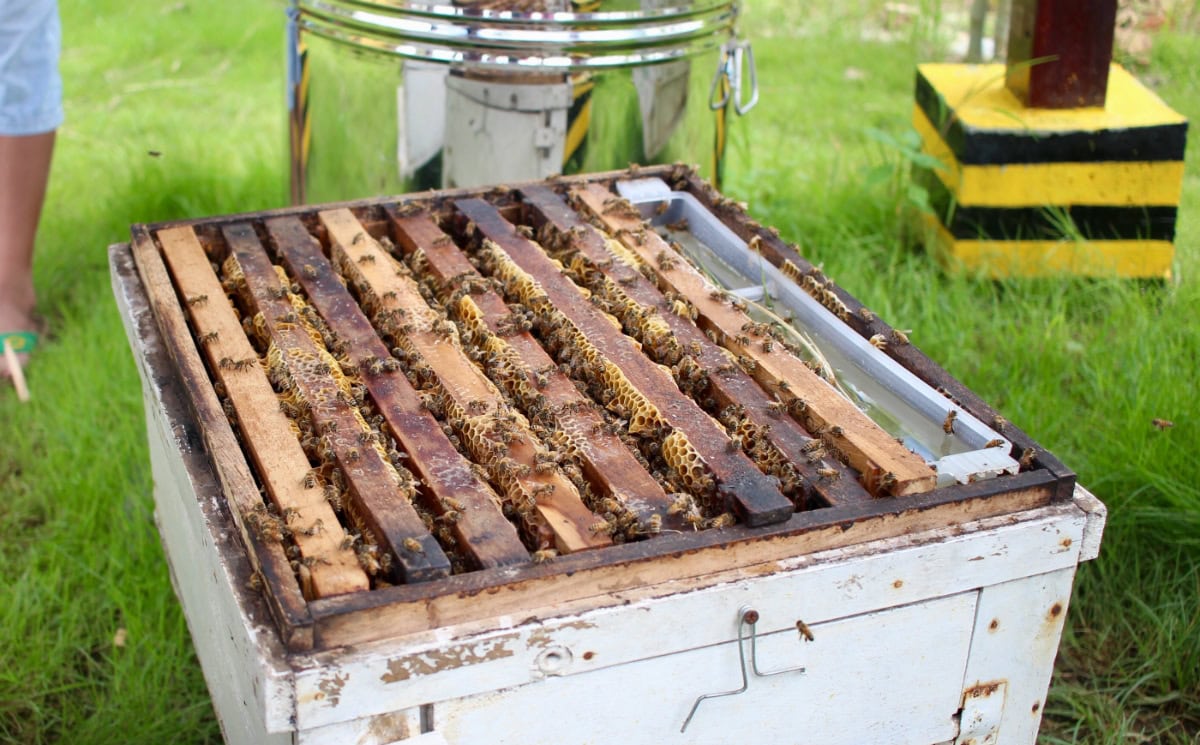
Aprivar: What It Is, What it Does, & How to Use It
Varroa destructor. It sounds like an evil nemesis to a comic book hero. It isn’t Superman that fears this parasitic mite. The mighty honey bee is the target of the Varroa destructor, and it is the most serious pest of honey bee colonies globally. First discovered in the United States in the mid 1980s, Varroa infestations have virtually wiped out most North American feral or wild bee colonies, as well as up to 40% of managed honeybee colonies annually in the United States.
Varroa mites harm bee colonies in two ways. First, they feed directly on the fat body tissue of developing bee brood and adult honey bees. Colonies may look healthy and produce good honey crops, only to dwindle and die suddenly during colder months. Colonies with large bee populations produce more brood, which allows mite populations to grow. The mites can harm the bees indirectly, too. These mites serve as vectors of over 20 viral diseases that can kill bees. These secondary infections, facilitated by the mites compromising the bees’ immune systems, lead to Parasitic Mite Syndrome (PMS), a condition that can kill a bee colony within only months of infestation.
Apivar. What It Is-
Fortunately, the Varroa mite species has found its match in Apivar, a treatment that literally stops Varroa mites in their tracks. The active ingredient is a miticide called Amitraz, which paralyzes the mite. A Varroa mite can’t hold on to the bee and falls to the bottom of the hive and starves. Adding to treatment success is a specifically designed plastic polymer strip that releases amitraz from the surface of the strip over time. Continuous release over a minimum six-week period allows safe and effective control of Varroa mites and ultimate hive protection.
Apivar. What It Does-
Apivar works by contact over time. Bees walk on the surface of the plastic polymer strip and pick up molecules of the active ingredient. Continued movement distributes these molecules all over the time. As bees walk on the strip’s surface they pick up molecules of the active ingredient and then distribute them throughout the colony.
Because it is only affective by contact, it is imperative to position Apivar strips in areas of high bee activity. This is usually the center of the brood area. There bees come in frequent contract with the strips and distribute amitraz into more areas. Activities such as bee feeding increase movement and amitraz exposure.
Aprivar. How to Use-
Using Apivar for Varroa mite treatment and prevention is easy. First, here are Apivar instructions on how to install properly, and then we offer some important rules for the most effective treatment possible.
Installing Apivar in the hive is easy. For safety, do not handle Apivar with bare hands. First, tear open the foil pouch, remove the strips from the wrapping and follow these steps.
- Remove honey supers before applying Apivar. (A honey super is a box placed on a hive with frames of comb to collect excess honey from a hive.)
- Separate the double rigid strips.
- Use the strips’ die-cut triangle as hanging hooks, or use a toothpick to suspend the strips between frames (preferred method).
- Hang each strip between two comb frames in the brood area or the bee cluster with a minimum distance of two frames between strips. Suspend Apivar strips in the brood chamber so bees can walk on both sides of the strips.
- Leave strips in the hive for a minimum of 42 days and remove. Do not reuse them.
When is the best time to treat?
- During the late summer or as soon as possible after removing supers (after the last honey harvest of the season). Apivar does not have temperature restrictions.
- Treat all colonies simultaneously to avoid reinfestation.
How many dosages are required?
- The recommended dosage is 2 strips per deep brood box full of bees, as effectiveness is not guaranteed with a lower dose. Do not use more than two strips per brood box, as a higher dose increases risk of leaving residues.
- Frames covered with bees: <5 frames: 1 dosage. 6-10: 2 dosages. 11-15: 3 dosages. 16 or more: 4 doses.
Where do I place them in the hive?
- Place the strips in the heart of the brood nest, not on the edge.
- You can check position of your Apivar strips during treatment and reposition if necessary.
- If the bee cluster moves away from the strips, reposition the strips into the bee cluster, and leave them in place for 14 more days before removal.
- Pay attention to duration of treatment. To avoid encouraging the development of resistance, do not leave the strips in place throughout the winter season.
- In case of heavy infestation, you can leave the strips for up to 56 days, but be sure to remove them after this period.
What is Apivar’s shelf life?
You should use Apivar within 24 months after the manufacturing date, which is stamped on the bottom of the package. Apivar’s polymer material is blended with the active ingredient of Apitar, amitraz. Strips are vacuum-sealed, so amitraz release is activated when the package is opened, and bees come in contact with it. Even in unopened packages, however, amitraz degrades over time. Stability cannot be guaranteed 24 months following manufacturing date.
Should I consider temperature when storing or using Apivar?
Temperature is not a factor you need to consider when storing or using Apivar treatment. It has been used in climates where outside temperatures are regularly over 100° F. Cooler temperatures do lower bee activity, and this can lower the dispersal of Apivar for short periods of time.
Will my hive become resistant to Apivar?
Four studies published in peer reviewed journals from across the globe showed that, when used correctly, Apivar is 97% effective in Varroa mite control. One of these studies showed that the formulation and delivery of amitraz helps to prevent the development of genetically-resistant mites.
To help prevent resistance, you should remove the strips after 42 days, or 56 days for extreme infestations. Also, use Apivar only when you need to treat for mites, not for preventative means.
Is Apivar safe for my hive? Does it end up in my honey?
Apivar is safe for bees and hives because of its quality components and advanced controlled-release technology. Recent studies show that none of the active ingredient, amitraz, was detected in honey, even in colonies treated with 10 times the recommended dosage.
What happens if I leave my honey super on the hive during treatment.
Treatment can be slightly less effective if you leave the honey super in the hive. That honey is just there for bee consumption, not human use. Begin using strips after the honey supers have come off for the year. Simply spin it off and eat the honey. You can either give it back to the hive to clean up or store it wet until next season.
When you follow Apivar instructions and guidelines, it can be a safe and effective treatment in Varroa mite control when you find your colonies at risk.
